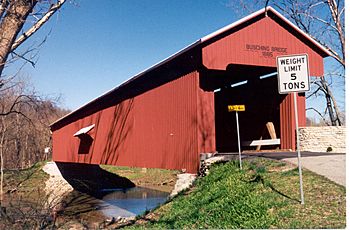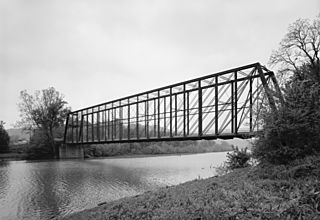Laughery Creek facts for kids
Quick facts for kids Laughery Creek |
|
|---|---|

Built in 1885, the historic Busching Covered Bridge crosses Laughery Creek just below the Versailles Lake Dam.
|
|
| Country | United States |
| State | Indiana |
| Region | Ripley County |
| Cities | Versailles, Friendship, Milton |
| Physical characteristics | |
| Main source | 993 ft (303 m) 39°11′29″N 085°19′42″W / 39.19139°N 85.32833°W |
| River mouth | Ohio River Border of Indiana and Kentucky 454 ft (138 m) 39°01′52″N 08°45′24″W / 39.03111°N 8.75667°W |
Laughery Creek is a long stream, about 88.6 miles (142.6 km) long. It flows through three counties in southeastern Indiana: Ripley, Dearborn, and Ohio. This creek eventually flows into the big Ohio River.
Contents
Discover the History of Laughery Creek
Laughery Creek got its name from a sad event during the American Revolutionary War. This event is known as Lochry's Defeat. It happened near the mouth of the creek on August 24, 1781.
Lochry's Defeat: How the Creek Got Its Name
During the war, Colonel Archibald Lochry and his soldiers were traveling down the Ohio River. They stopped near the creek to cook some fresh bison meat. Suddenly, they were attacked by Joseph Brant, a Mohawk leader. Colonel Lochry and 40 of his men were killed in this ambush. The creek was later named in their memory.
Busching Covered Bridge: A Historic Crossing
The Busching Covered Bridge crosses Laughery Creek. You can find it on Covered Bridge Road. This bridge is just below the Versailles Lake Dam. It is 176 feet (54 meters) long and was built in 1885. Thomas A. Hardman was the builder.
The wood for the bridge's top part came from a local Baptist church site. The bridge uses a special design called a modified Howe truss. This design helps the bridge handle different weights and forces.
Triple Whipple Bridge: A Unique Design
The Triple Whipple Bridge, also called the Laughery Creek Bridge, is another important crossing. It spans 300 feet (91 meters) of Laughery Creek. This bridge is close to where the creek meets the Ohio River. It was built in 1878 by the Wrought Iron Bridge Company.
Its name comes from its special design. It is the last "triple-intersection Pratt truss" bridge in the whole United States. Today, it is a bridge for people to walk across. It connects Ohio and Dearborn counties. This historic bridge is listed on the National Register of Historic Places.
Explore the Path of Laughery Creek
Laughery Creek drains a large area of land, about 343 square miles (888 square kilometers). It starts in northwestern Ripley County. This is southwest of Napoleon.
The creek first flows northeast, then southeast towards Versailles. After Versailles, it turns east. It forms the border between Dearborn and Ohio Counties. Finally, Laughery Creek flows into the Ohio River. This is about 2 miles (3.2 km) south of Aurora, Indiana.
Versailles Lake Dam: A Man-Made Lake
In 1954, a big dam was built across Laughery Creek. This dam created Versailles Lake, which is 230 acres (93 hectares) big. Fish cannot swim past this dam to go upstream. Versailles Lake is part of Versailles State Park.
Wildlife and Nature Around Laughery Creek
Versailles State Park has lots of natural woods along Laughery Creek. Long ago, this area was a very thick forest. Many types of trees grow here.
Common Trees in the Area
Some of the main trees you can find are:
- American beech
- White ash
- Blue ash
- Sugar maple
- Chinquapin oak
- Red oak
- Shagbark hickory
- Tulip tree
- Ohio buckeye
- Black walnut
Rare Animals in the Laughery Creek Area
Some rare animals live in the Laughery Creek watershed. These include:
- The bobcat (Lynx rufus)
- The Henslow's sparrow (Ammodramus henslowii)
- The northern harrier (Circus cyaneus)
- The barn owl (Tyto alba)
River Otters Return
Between 1995 and 1999, river otters (Lontra canadensis) were brought back to Indiana. The closest place they were released was the Big Oaks National Wildlife Refuge. From there, these otters, which were once endangered in the state, have returned to the Laughery Creek area.
Fish Species in the Creek
In 1995, a survey looked at the fish in Laughery Creek. The most common fish found was the bluntnose minnow (Pimephales notatus). It made up 19% of all the fish. Other common fish included:
- Longear sunfish (Lepomis megalotis) (14%)
- Gizzard shad (Dorosoma cepedianum) (12%)
- Golden redhorse (Moxostoma erythrurum) (11%)
There were 53 other kinds of fish found. Each of these made up 6% or less of the total fish.
Fun Activities at Laughery Creek
You can have a lot of fun at Laughery Creek! Many parts of the creek below the Versailles Lake Dam are great for canoeing. Fishing is also a very popular activity here.
Fishing Opportunities
The creek offers good fishing for several types of bass. These include:
- Rock bass (Ambloplites rupestris)
- Spotted bass (Micropterus punctulatus)
- Smallmouth bass (Micropterus dolomieu)
You can also catch many kinds of panfish, like the longear sunfish. In the spring, during spawning season, you can catch sauger (Stizostedion canadense) and white bass (Morone chrysops). These fish swim up from the Ohio River into Laughery Creek. They can be caught all the way up to the dam at Versailles.


